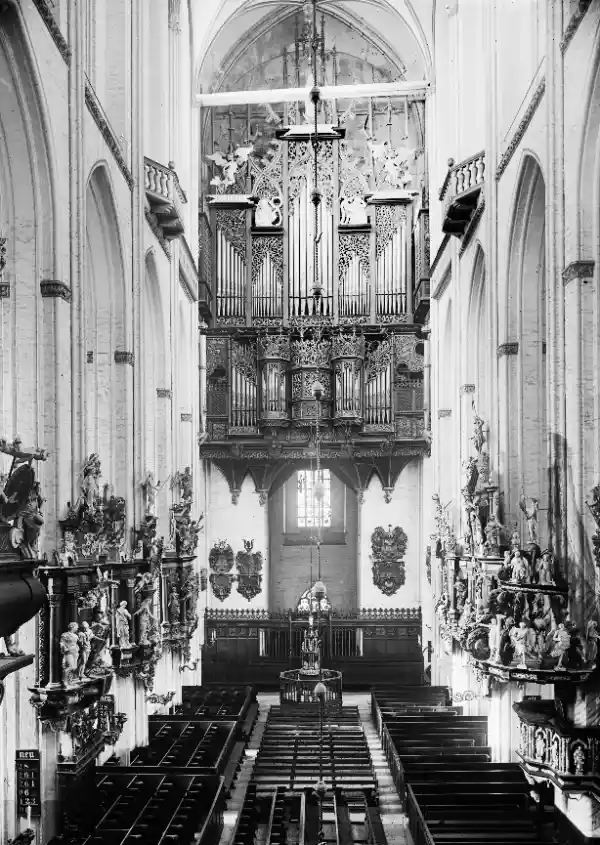Our organs
Impressive sound for your ears
Organ music in St Marien has been one of the most important pillars of culture in our city since the 14th century.
Organs at St Marien
Significant instruments
With the construction of the large organ by Barthold Hering – the huge Gothic façade adorned St Marien for over 400 years – and the extensions to both organs by Friedrich Stellwagen, St Marien had impressive and very high-quality instruments at its disposal. They inspired the compositions and improvisations of the musicians at this church, of whom Franz Tunder and Dieterich Buxtehude are particularly well known worldwide.
With the destruction of Lübeck in the Second World War, this history of development came to an abrupt end. After the church was rebuilt, Walter Kraft initiated the construction of two new large organs, which were completed in 1955 (Totentanz organ) and 1968 (grand organ) under adverse conditions. After the devastating world war, there was a shortage of materials, expertise and financial resources. As early as 1985, the Totentanz organ made by Kemper had to be replaced. The new Totentanz organ made by Führer was also intended to compensate for the tonal weaknesses of the large organ. Today, both organs are under discussion. An expert opinion commissioned in 2010 identified significant deficiencies, particularly in terms of sound and technology.

The Great Organ (Kemper Organ)
Until 2022, the main organ used in church services and concerts was the "Great Organ" or Kemper Organ in the westwork, one of the largest church organs with mechanical action ever built. It was delivered in 1968 by Kemper & Sohn after six years of construction.
The enormous instrument has 101 sounding voices with 8,512 pipes on five manuals and pedal. The Great, Brustwerk and Rückpositiv form the core of a "Buxtehude organ". In addition to the basic voices, the Kronenwerk and Oberwerk contain additional registers for older and modern sound images, so that the instrument can be used to interpret the literature of all eras in a stylistically appropriate manner.
Due to renovation work continuing until 2030, the organ was dismantled in 2025. The organ has been out of service since 2022. The main reasons for this were structural problems and major issues with the outdated electrical system.
A new organ is currently being discussed.
The Dance of Death Organ (Totentanz Organ)
The new Dance of Death organ was built in 1985/86 by the Alfred Führer company in Wilhelmshaven. It is not a replica of the 15th-century organ surveyed in 1937. The Dance of Death organ used to hang in the Dance of Death Chapel, where the Astronomical Clock is located today. The current Dance of Death organ is already the second instrument since the Second World War. The organ built in 1955 by Kemper&Sohn was in need of frequent repairs.
The sound and external design of the current Dance of Death organ correspond to the ideas of our time. It is particularly well suited to compositions from the 17th and 18th centuries, especially those by Johann Sebastian Bach. Despite the reverberant acoustics in St Marien, the clearly defined voices allow for a richly contoured and contrasting performance. The new Totentanz organ has 56 stops and 4,479 pipes on the Great, Rückpositiv, Brustwerk, Oberwerk and Pedal.
Die Hausorgel (Home Organ)
The small house organ in the Letter Chapel originates from East Prussia.
It was used in church services for 200 years in the castle chapel of Dönhofstädt near Rastenburg. In 1933, the Lübeck organ builder Karl Kemper acquired the instrument. With the help of the Possehl Foundation, the organ was installed in the high choir of St. Catherine's Church in 1937 for musical performances. Until the renovation of the Letter Chapel, it was used there mainly during winter church services.
Currently, this organ also needs to be extensively refurbished.


